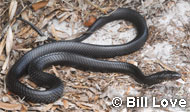Description:
This is a state and federally threatened species. Much mystique accompanies the eastern indigo snake that despite its endangered status it remains coveted by hobbyists. States where indigos are indigenous usually prohibit hobbyists from having the snakes. Excluding such prohibitions though, sales within a given state (intrastate sales) are legal without a federal permit; sales between states (interstate) sales require permitation. There is no question that this heavy-bodied, glossy, bluish-black snake is an impressive beast. There is also no question, as those who have kept them have learned, that they are a messy snake. Indigos are not constrictors but have catholic tastes. They eat frogs, toads, salamanders, birds, small mammals, lizards, baby turtles and other snakes, including pit vipers. Hatchling indigos may eat some invertebrates but at a hatchling length of 17 to 24 inches the snakes are well able to overpower and consume frogs and small rodents. Captives thrive on prekilled rodents but actually seem to enjoy a varied diet. Indigos are active, alert, and until acclimated, shy. They should be given a large terrarium containing a hide-box and assorted visual barriers (such as cork bark or sterilized drift wood). One or two babies may be temporarily housed in a 20 to 30 gallon capacity terrarium. But one or two adults should be housed in a 125 gallon capacity (or larger) Indigos are not accomplished climbers but if unfrightened they will coil and rest on an elevated shelf when one is provided. Cypress, fir, aspen chips or bark shards are excellent choices for a substrate. A temperature of 68 degrees Fahrenheit at night and 76 to 82 degrees during the day is ideal for these snakes. A hot spot of 95 degrees should be provided for several hours a day. A large water bowl (kept scrupulously clean) should always be provided. The snakes will both drink, and if the receptacle is large enough, soak in the bowl. Winter cooling (but not necessarily dormancy) seems necessary (or at least beneficial) to cycle this snake for breeding. It seems that the period of dormancy is more necessary for wild-caught beauty snakes than for those that have been bred for several generations in captivity. Breeding occurs from late summer to midwinter. Clutches contain from 3 to a dozen eggs. When generously fed the young grow quickly and can measure a yard or more in length in a year’s time.
Habitat:
Although the size of the home range of an indigo snake varies by the snakeâs age and sex as well as seasonally, indigos require immense tracts to flourish. Adult females range over ranges that average 80 (45 to120) acres in size and adult males utilize up to 4 times that amount of space. They are traditionally associated with scrub and open pinelands. If gopher tortoises are present their burrows serve as retreats for the snakes. Indigos may survive on cleared agricultural and pasture land as long as adequate cover is present. These snakes wander most widely during the warm months of the year but are active throughout the winter on all but the coldest days.
Range:
This is an uncommon snake of the southeastern coastal plain. It occurs in Florida, eastern Georgia, southern Alabama and may continue to exist in extreme southeastern Mississippi.
Scientific Name: Drymarchon corais couperi
Species Group:
Family: Colubridae
Size: Commonly attains 6 feet in length; occasionally exceeds 8½ feet.
Level: intermediate
Weight:
Dangerous: No


